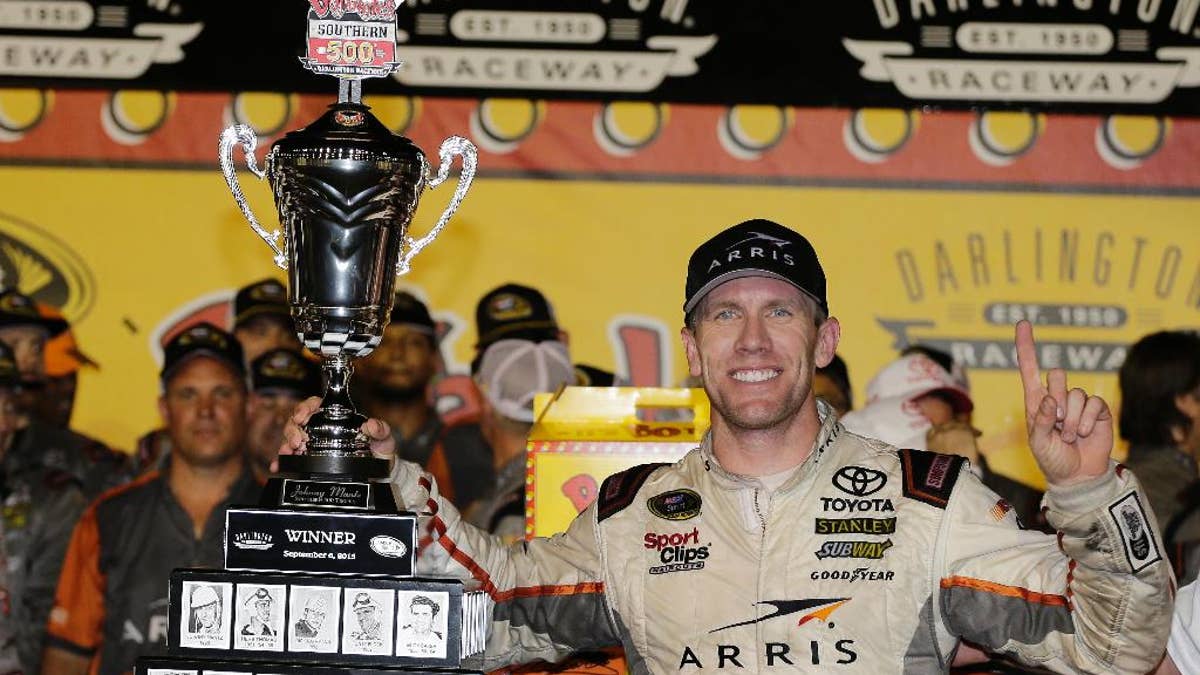
Carl Edwards celebrates in victory lane after winning a NASCAR Sprint Cup auto race at Darlington Raceway in Darlington, S.C., Monday, Sept. 7, 2015. (AP Photo/Terry Renna) (The Associated Press)
CHARLOTTE, N.C. – Moments after Carl Edwards climbed from his winning Southern 500 car, he began lobbying for NASCAR to apply the rules package used at Darlington Raceway in the upcoming playoffs.
Edwards and his Joe Gibbs Racing teammates are among the loudest supporters of an aerodynamic package that has been experimented with twice this summer, most recently Sunday night at Darlington Raceway. Although his drivers want the low-downforce package used in the 10-race Chase for the Sprint Cup championship, team owner Joe Gibbs is content using the much-maligned current rules.
"There's some things that I can't change, and NASCAR said 'Hey, look, we're not going to go changing things and go to a different package for the Chase,' and I think that's fair," Gibbs said Tuesday in a telephone interview.
NASCAR did indeed announce on Aug. 14 that the current package will be used in the Chase, which begins next week. The decision came five weeks before the playoffs begin, and Gibbs agreed with NASCAR's rationale that there wasn't enough time for teams to prepare for a new package that would be when the stakes are the highest.
"That's fair, and that will be a fair way for us to approach the Chase this year," he said.
That's in direct contrast to what the sport's biggest stars want.
NASCAR chairman Brian France has tasked his upper management with improving the on-track product, which has becoming increasingly boring this year. The poor on-track product came as a bit of a surprise after the dramatic racing that occurred in last fall's 10-race playoffs.
As the quality of racing deteriorated throughout the spring, NASCAR decided to in-season test some different aerodynamic packages. The tests, though, came during actual Sprint Cup races, giving fans a glimpse of three different ideas: The current rules package, the low-downforce package used at Kentucky and Darlington, and a high-drag package used at Indianapolis and Michigan.
The current rules aren't satisfying anyone, and the low-drag package did nothing to improve the racing. But the low-downforce package has wide support, mostly because the majority of the elite drivers strongly back these rules, which make the cars difficult to handle and forces the wheelmen to up their game.
"It separates the racecar drivers from the pretenders, and that's the way it should be," said Darlington runner-up Brad Keselowski.
It's quite possible NASCAR will ultimately use a version of the low-downforce package when setting the 2016 rules, and series executive vice president Steve O'Donnell seemed to indicate after Sunday's race that the sanctioning body was pleased with the show at Darlington.
Still, O'Donnell reiterated that the rules won't change for the Chase, something Edwards made a strong campaign for after his win.
"I'm kind of a shoot-for-the-moon kind of guy," he said about his hope that NASCAR couldn't overlook the racing throughout the field Sunday.
"Everybody has developed this package. I believe it's pretty obvious that it races really well and it's really fun to do and it's fun to watch."
JGR has certainly excelled at this package. At its debut in July at Kentucky, all four JGR drivers finished in the top five and Kyle Busch went to victory lane. Edwards won at Darlington, while Denny Hamlin and Busch finished third and seventh.
But JGR has shown it can win this season anywhere and under any rules package. Busch won in the first race with the high-drag package, and all four JGR drivers have won races using the 2015 rules package. The organization has won 10 races this year, seven of those wins coming in the last 10 events.
Even with that proven record this year, Hamlin is on board with scrapping all rules packages right now in favor of the lower downforce. At Darlington, where Hamlin finished third, Goodyear had enough notice about the rules to prepare a companion tire that was softer and made degradation a major theme of the race.
Drivers were forced to conserve their tires, and combined with a car that was more difficult to drive, it contributed to the track record 18 cautions.
"It's the package we need to run from now on," said Hamlin. "It's unbelievable how much tire fall-off there is. You're sliding around, there's more wrecks, which is unusual, but it's a good thing because guys are messing up.
"That happens every now and then in racing. It's a lot of fun from our perspective."
Alas, the package likely won't be seen again until next year, and NASCAR needs to hope the racing the final 11 weeks is dramatic and series leaders don't end up with egg on their face for failing to make a change that fans so clearly support.
Pleasing the fans, after all, is ultimately what NASCAR wants most. Gibbs expected fan feedback to drive NASCAR toward embracing the low-downforce at least for 2016.
"I think (fans) saw Kentucky, they saw this past weekend, and I think what you are going to find is they are going to be voting — voting by calling the radio, by TV, they are going to be writing letters and they are going to say 'This is what we want,'" Gibbs said. "And I'd be willing to bet you that NASCAR is going to listen."
